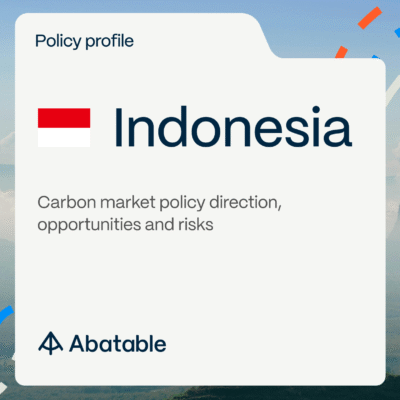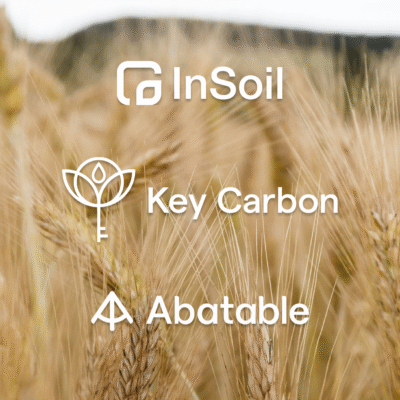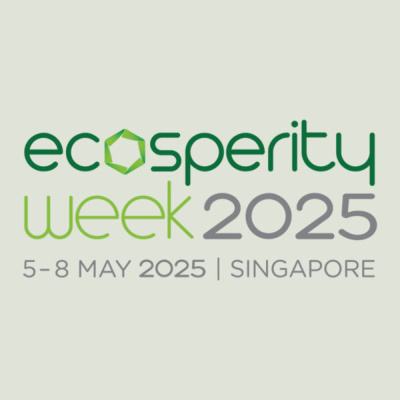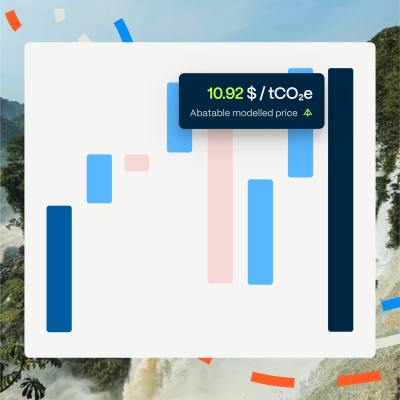Abatable’s 2024 VCM Investment Attractiveness Index is out, and Colombia leads the ranking this year thanks to a rich supply of in-demand credits and a healthy developer ecosystem. The shifts in country positions seen in 2024 were spurred by focused engagement with Article 6 and show trends of strong regional activity.
As the sun rises on the Chocó–Darién forest region on Colombia’s Pacific coast, endangered species including spider monkeys, jaguars, and giant anteaters begin their day swinging through the humid canopies, hunting prey and foraging for food.
This moist tropical forest, teeming with an array of unique flora and fauna, is also home to a series of REDD+ forest conservation projects set up to protect this one-of-a-kind ecosystem. While the animals go about their daily routines, community groups – supported by carbon project finance – patrol, monitor and detect unauthorised activities within their communal forests. They work to protect the area from cattle ranching, mono-agriculture and logging pressures that threaten widespread deforestation and, as a result, climate damage and the potential loss of these unique species.
Similar projects operate across Colombia, a country that hosts 10% of the world’s biodiversity and one that is fighting hard to turn the tide on deforestation. Colombia has reduced or removed 143mn tonnes of CO2 through carbon markets since 2008, mainly through REDD+ and Aforestation, Reforestation and Revegetation projects, with 80% of this activity happening over the last five years.
Its teeming biodiversity, its significant primary forest cover – in Chocó-Darién and elsewhere – and a healthy carbon project developer ecosystem supplying in-demand credits have positioned Colombia in first place in Abatable’s VCM Investment Attractiveness Index for 2024.
The VCM Investment Attractiveness Index
Abatable’s VCM Investment Attractiveness Index ranks countries according to their current voluntary carbon market conditions and their potential to play a significant role in the future of carbon markets. It was designed to provide capital allocation risk insights to investors, aid governments in setting carbon market-friendly policies and allow carbon credit buyers to better understand the political landscape behind the credits they are sourcing.
The VCM Index, originally built in collaboration with Howden, is framed around three pillars that analyse countries’ investment landscapes, their readiness to engage with national and international carbon markets and the opportunities available for the VCM to improve their environmental and social conditions.
This is the second year Abatable has produced the Index, with the factors under consideration for each pillar being expanded in the 2024 edition. The two years’ worth of data enables the generation of both temporal and geographical insights from this year’s results, which we explore in this article.
You can access the full Index here and its methodology here.
The countries topping 2024’s rankings
Colombia
Index rank number: 1 (2023 placement: 13)
Overall Index score: 81.0
Global carbon market readiness score: 92.8
Investment landscape score: 60.5
Climate, nature and people opportunity score: 80.3
The only country in South America that has coastlines on both the Atlantic and Pacific oceans, Colombia’s unique geography comprising deserts, highlands, grasslands, mangroves and rainforests means it is one of the world’s 17 megadiverse nations – a group of countries that house the majority of the Earth’s species.
These conditions, boosted by its share of the Amazon rainforest which spreads into Brazil and Venezuela to the East and Peru and Ecuador to the South, are one of the reasons Colombia has topped 2024’s VCM Investment Attractiveness Index.
Colombia’s forests are currently threatened by deforestation and degradation due to mining, cattle ranching and illegal logging activities. The carbon market is thus a valuable tool to mitigate and reverse the adverse effects these harmful activities inflict on the integrity and health of the forests, placing Colombia in the top ten of the Index’s Climate, nature and people opportunity pillar.
Colombia houses over 60 million hectares of biodiversity-rich forests, containing 10% of the world’s species and housing around 26bn tonnes of CO2. That’s despite making up only 0.7% of the planet’s landmass. As a result, the country offers a rich supply of in-demand carbon credits, particularly from its Amazon and Pacific regions. Colombia has emerged as the global leader in nature-based solution (NBS) carbon credit issuances, with 142mn tonnes issued since the market’s inception (as of September 2024).
Over the last two years, 38 carbon project developers have operated in the country, placing it in fifth place for this indicator behind the US (122), India (112), Turkey (78) and China (65).
The other major reason Colombia has scored so highly this year is its strong performance in the Global carbon market readiness pillar. Colombia has embraced carbon markets and the bio-economy as part of its long-term decarbonisation strategy, supported by strong government policies.
Colombia’s innovative approach to carbon pricing, implemented in 2016, showcases a blend of compliance mechanisms and voluntary carbon markets. The country’s carbon tax includes a flexibility mechanism allowing companies to offset their tax obligations using carbon credits.
Initially permitting 100% offsets, this was reduced to 50% in 2022 to balance market dynamics and emissions reduction goals. Crucially, only credits from Colombian projects are eligible – a policy that has significantly boosted local carbon credit supply. This localised approach has stimulated Colombia’s national carbon market while addressing its emissions reduction targets, positioning the country as a leader in integrating carbon markets with national climate strategies.
Additional data integration
For this year’s Index Abatable processed more data and dived into local markets in greater depth. This included the additional integration of the COLCX and Cercarbono carbon credit registries into our dataset, which were developed in response to the country’s compliance scheme. Some 95% of historic retirements from COLCX and 75% from Cercarbono have been used for compliance purposes in Colombia.
The country’s compliance scheme has had a strong impact on Colombia’s 2024 Index placement, particularly in regard to the level of issuances of project types in high demand from buyers, such as Afforestation, Reforestation and Revegetation.
We expect that other countries developing carbon credits-linked compliance schemes, such as Indonesia, Viet Nam, Brazil and India, to improve their investment attractiveness and rankings in future editions of the Index.
Colombia’s commitment to advancing its carbon policy remains strong, with the country’’s Ministry of Environment and Sustainable Development (MADS) announcing a draft decree to establish a framework for an Emissions Trading Scheme (ETS). This move demonstrates the current government’s dedication to further developing the country’s carbon market mechanisms.
Kenya
Index rank number: 2 (1)
Overall Index score: 80.1
Global carbon market readiness score: 95.9
Investment landscape score: 57.8
Climate, nature and people opportunity score: 75.0
A country rich in lowland and mountain forests, grasslands, and wetlands, and ranking in first place last year, Kenya continues to hold a prominent position in the VCM Investment Attractiveness Index. Its positive performance stems primarily from its engagement with Article 6 of the Paris Agreement, as well as from a favourable supply of in-demand carbon credits, with the country issuing approximately 20% of Africa’s total carbon credits from 2016 to 2021.
From a Climate, nature and people opportunity perspective, Kenya’s exceptional biodiversity, which encompasses over 35,000 species of flora and fauna, is supported by a diverse landscape of marine ecosystems, mountains, tropical regions, drylands, forests, and arid lands. This includes 467 inland lake and wetland habitats covering about 2.5% of the country’s total area, offering significant potential for NBS credits.
Building on its extensive experience in the VCM, Kenya has recently taken steps to enhance its carbon market regulatory frameworks and launch an Article 6 regulatory framework, enhancing its Global carbon market readiness score.
The country stands out as one of the few African countries – alongside Rwanda, Ghana, Tanzania, and Zambia – to have established an Article 6 regulatory framework, positioning it at the forefront of international Article 6 engagement. This development, paired with strong governmental support, including Kenya’s President actively promoting carbon credits as a significant export, further enhances Kenya’s attractiveness in the sector.
Kenya’s Climate Change (Amendment) Bill of 2023, followed by the Climate Change Carbon Markets Regulations in 2024, have resulted in a more robust and project-friendly environment for carbon projects and investments in the country.
These new policies introduce two key elements: a national carbon registry to streamline operations, and rules for benefit-sharing from carbon projects in the country. Under these regulations, Indigenous peoples and local communities are guaranteed a substantial share of profits from carbon projects in Kenya. This approach not only addresses past concerns about community displacement but also sets a new standard for equitable participation in the VCM.
The voluntary carbon market in Kenya also faces some challenges. The country’s economic landscape has seen some fluctuations, and inflation rates have risen from 6% last year to 6.6% currently. This increase has contributed to a slight cooling in the investment climate, adding a layer of complexity to Kenya’s carbon market development and slightly reducing its score in the Index’s Investment landscape pillar.
Despite these economic headwinds, Kenya continues to pursue its carbon market ambitions, and the balance of its regulatory advancements with the challenges posed by the broader economic context means it remains within the top three countries in this year’s Index.
Cambodia
Index rank number: 3 (7)
Overall Index score: 80.0
Global carbon market readiness score: 95.3
Investment landscape score: 60.8
Climate, nature and people opportunity score: 73.1
Cambodia’s biodiversity, encompassing a wide array of flora and fauna, is supported by varied ecosystems including the Tonle Sap Lake, the Mekong River floodplains and the Cardamom Mountains. These natural features provide a solid foundation for developing carbon projects that align with both climate mitigation goals and biodiversity conservation efforts in a country that has experienced significant levels of deforestation. These factors have given it a high score in the Climate, nature and people opportunity pillar.
Building on its commitment to climate action, Cambodia has been working to enhance its local carbon market framework. The issuance of the country’s comprehensive Article 6 operations manual in December 2023 marked a crucial development in the country’s preparation activities for Article 6 carbon markets, contributing to its high Global carbon market readiness score.
The operations manual introduces key elements such as a governance structure, with Cambodia’s Ministry of Environment acting as the Designated National Authority, a planned national greenhouse gas emissions registry, and clear processes for project authorisation and implementation.
Cambodia also stands out under the Global carbon market readiness pillar for its proactive engagement with Article 6, being one of the handful of countries with an Article 6 regulatory framework. It has also signed Memoranda of Understanding with Singapore and Japan for carbon trading. This positions the country as an early mover in bilateral carbon market mechanisms which, in turn, enhances its attractiveness to international investors and project developers.
The country’s recent regulatory developments and international partnerships have positioned it as an emerging player in Southeast Asia’s carbon landscape. Cambodia is adopting a cautious yet forward-looking strategy, with an Article 6 pilot authorisation phase set to run until December 2025. This initial period aims to build institutional capacity, fine-tune processes, and gather crucial insights before scaling up its Article 6 engagement.
Significant changes from 2023
Colombia, Kenya and Cambodia are followed by Mexico (Index score 79.4), Peru (79.2), Madagascar (78.7), Nigeria (77.9), Ghana (77.7), Brazil (76.3) and Zambia (76.3) as the top ten countries in this year’s Index – demonstrating a mix of new entrants and established VCM powerhouses.
It’s worth highlighting Madagascar’s big jump from 18th to 6th place, due to its strong performance in its number of unilateral authorisations (3) for Article 6 and the presence of an Article 6 Designated National Authority. Zambia also jumped to 10th position from 31st due to its establishment of an Article 6 regulatory framework and a drop in government expropriation risk.
Beyond the top 10, other countries made large strides forward in their attractiveness scores. The five countries with the biggest improvements on 2023 – Guyana, Timor-Leste, Gambia, Lesotho and Chad (see Figure 2) – all demonstrated a greater supply of in-demand credits and increased engagements with Article 6.
In addition, some of these countries reported higher emissions levels and diminished access to electricity. While these are negative outcomes from a climate, nature, and people lens, they translate to greater investment opportunities to improve conditions – and consequently to higher scores in these indicators in the Index.
In contrast, some of the countries that saw their scores lower the most saw reduced market activity over the last two years, particularly in terms of the number of credits issued and the number of active project developers in operation.
The Index also tracks whether a country has actually revoked any Article 6 credits. It’s worth noting that while countries progressing well with Article 6 may have jumped up the rankings this year, there could be a need to be cautious with countries authorising Article 6 credits without a clear strategy against overselling, and thus potentially jeopardising their NDC targets. This may give rise to the risk of revocation of credits in the coming years, which would be significantly harmful to a country’s investment attractiveness.
Regional clusters of strong activity
The 2024 VCM Investment Attractiveness Index also highlights areas with clusters of strong activity.
Latin America
The first is Latin America, which emerges as a powerhouse of opportunity in the VCM landscape. The region’s vast natural resources, particularly the Amazon rainforest, position it as a significant player in carbon credit generation, with it supplying 23% of global carbon credits over the last five years according to Abatable data.
A common trend across Latin American countries is the increasing engagement with both voluntary and compliance-based carbon markets. Countries traditionally sceptical of such mechanisms are now showing a newfound openness.
This shift has been recently evident in Ecuador and Bolivia, two nations that have historically approached carbon markets with caution. In a groundbreaking move, Ecuador’s Biodiversity Commission unanimously voted in August 2024 to support reforms to its Organic Environmental Code, paving the way for the explicit permission of carbon trading.
In parallel, Bolivia has taken similar steps towards embracing carbon market mechanisms. Its Constitutional Court legalised carbon trading in the same month, deeming a previous ban unconstitutional in light of the country’s ratification of both the UN’s Kyoto Protocol and the Paris Agreement on climate change. While this decision prompted a request for review from the vice presidency, it signals a significant shift in policy.
These and similar policy shifts are creating a more cohesive approach to climate action and carbon market participation in the region.
This concentration of countries with similar sustainable development goals – both in terms of adaptation and mitigation – and shared ecosystems, such as the Amazon Forest, presents a unique opportunity for cooperation, which could enhance the region’s collective bargaining power and efficiency in the global carbon market.
Recent research suggests that there’s an undercurrent of technical cooperation persisting in Latin America despite high-level political divisions. Regional cooperation often occurs at the bureaucratic level, involving government officials that continue to work together on practical issues despite political tensions.
This ‘quiet integration’ at the technical level offers a promising avenue for advancing carbon markets in the region. By focusing on practical, technical aspects of carbon market development, Latin American countries are able to build a foundation for more robust cooperation, even in the absence of high-level political alignment.
International support and capacity-building initiatives are also playing an increasingly crucial role in the region’s carbon market development, particularly as countries work to develop and refine their Article 6 frameworks. Organisations like the World Bank are providing technical assistance for designing and implementing carbon pricing instruments, helping countries to build robust market frameworks.
However, the investment landscape in Latin America remains complex. While external assistance is fostering market development, investors must navigate a varied terrain of local conditions and challenges. This complexity highlights the importance of continued international support and collaboration, not only in building capacity for Article 6 implementation but also in creating a more conducive investment environment across the region.
As Latin American countries continue to develop their carbon markets, the synergy between capacity building, international support, improved regulation and informed investment strategies will be key to unlocking the full potential of these emerging opportunities.
Africa
Similarly, clusters of African countries have also seen significant improvements in the 2024 Index. The countries are moving quickly to make the most of international carbon markets. Cross-border cooperation and knowledge sharing for Article 6 is evident in countries in the region, facilitating the progression of regulatory frameworks for Article 6 trading. It is no surprise that, to date, five of the six countries in the world that have an Article 6 regulatory framework are in Africa: Ghana, Kenya, Rwanda, Tanzania and Zambia.
Nigeria has also jumped to fifth position in the Index, from 14th, having signed an Article 6 unilateral authorisation and having Designated National Authorities focused on climate. Madagascar and Zambia have climbed the table for similar reasons.
Cooperatives such as the Africa Carbon Markets Initiative are working to scale high-integrity carbon markets in the continent, advocating for increased demand and investment and convening actors to build consensus, attract capital and scale supply.
Beyond carbon markets, Africa is making significant strides in overall climate finance. The African Development Bank has consistently exceeded its target of allocating 40% of its total financing to climate finance, reaching 55% in 2023. However, annual climate finance flows to Africa currently stand at only about $30bn, far from the estimated $2.5-2.8tn needed between 2020 and 2030 to implement the continent’s Nationally Determined Contributions under the Paris Agreement.
Asia
Cambodia, which has a long history of supplying carbon credits, strong engagement with Article 6 and a robust REDD+ experience, comes in third place in 2024’s Index. There have also been plenty of other positive stories across the continent, giving investors reason to be focused on the region.
From a Global carbon market readiness perspective, Many Asian countries are developing compliance schemes with crediting mechanisms. For example, Indonesia launched an emissions trading scheme last year, and India, Viet Nam, Malaysia and Thailand are currently finalising plans to operationalise schemes in the coming years.
Given these countries’ rapidly developing economies, with growth still coupled to emissions levels, large internal markets will drive increased credit demand, and investment will follow.
Meanwhile, Thailand has completed the first-ever transfer of ITMOs under Article 6.2 to Switzerland, while Papua New Guinea is one of only two countries that has a list of eligible credits to supply Singapore’s carbon tax. Numerous other countries are actively working on carbon market regulations and Article 6 frameworks, which are expected to be implemented in the coming year.
Fiscal incentives to stimulate market development are also appearing, with tax deductions and exemptions mooted by governments in Malaysia and Viet Nam to support carbon project development.
Asia also represents a lot of potential carbon credit demand in the coming years. Singapore, Japan and South Korea are driving a lot of early activity on the demand side of the market and regional connections may help foster market connections across the continent. Regional clusters are also beginning to form, for instance at the ASEAN level through the ASEAN Alliance on Carbon Markets.
For more country-level market and policy analysis, view our policy profiles.
Further increasing investment attractiveness will aid much-needed finance flows for climate change
One final observation from this year’s VCM Investment Attractiveness Index data is that there are key reasons different countries are attractive from a VCM perspective, with some disparate trends evident in developed and emerging economies.
Figure 3 displays countries’ scores in the Global carbon market readiness pillar. The chart reveals a clear distinction between emerging economies and developed economies, with regions such as Africa, Southeast Asia, and Latin America scoring highly in terms of their carbon market readiness, reflecting a growing opportunity to expand carbon markets and capitalise on international climate finance.
With vast natural resources, countries in these regions are well-positioned to supply the types of carbon credits in high demand globally, such as Afforestation, Reforestation and Revegetation, improved forest management and soil carbon. As international carbon markets evolve, emerging economies are incredibly well placed to unlock these substantial economic, social and environmental benefits.
Figure 4 on the other hand displays countries’ scores in the Investment landscape pillar, which also shows a clear distinction between emerging and developed economies due to the relative differences in macroeconomic and trade network development.
This dynamic hides a major opportunity. Developed economies often rank lower on the Global carbon market readiness scale, meaning they may not be as well-positioned to engage in carbon markets as effectively as their counterparts. This presents a compelling case for the significant flow of capital from developed to emerging economies where the potential for carbon markets is immense.
Innovations in financial services are already emerging to help facilitate these financial flows. For example, companies like Oka and Kita in the UK, and CarbonPool in Switzerland, have developed specialised insurance products to mitigate some of the investment risks associated with carbon markets. These kinds of tools can further facilitate the transfer of capital by offering further security and confidence to investors looking to engage.
In exchange, emerging economies can benefit from these investment flows and opportunities in the form of job creation, increased public income from selling mitigation outcomes and increased funding for ecosystem protection and technology transfer.
It is this opportunity, and the facilitation of these financial flows, that will play a crucial role in the fight against climate change. This will enable carbon markets to fully play their part in protecting vital ecosystems such as Cambodia’s Chocó–Darién forest region, and in building a positive future for climate, nature and people.
Access Abatable’s full 2024 VCM Investment Attractiveness Index
You can access the 2024 VCM Investment Attractiveness Index through Abatable’s new and improved intelligence platform. Sign up to view the top 40, the Index’s pillar and indicator breakdown for each country, and interactive maps displaying country performances.
Our new platform is designed to democratise access to crucial carbon market data, enabling a wider range of participants to access the tools to de-risk and succeed in an often opaque and evolving landscape.
Within our new platform, alongside the Index, users can immediately access:
- Key policy information for over 80 countries through our policy profiles;
- Total carbon credit price ranges by project type via our pricing insights module;
- Global carbon credit supply and demand trends;
- Full access including search across Abatable’s blogs, webinars, podcasts and reports in our knowledge hub; and
- Access to current and past expert-filtered market updates in our news section.
For more on Abatable’s services for investors, carbon credit buyers and carbon project developers, visit our website.
The VCM Investment Attractiveness Index 2024 was led by Alejandro Limón Portillo, with support from Greg Lydka Morris and Abatable’s Knowledge and Data team.
The product and engineering team behind the Index and market intelligence platform are Lucija Penko, Susana Lopes, Anton Jidkov, David Williams, Jenny Vuu, Dan Williams, Dan Keen, Akash Payne and Eoghan Hynes.
Words and insights in this article by Alejandro Limón Portillo, Valentina Hernandez Gomez, Greg Lydka Morris and Marc Height.



































































































